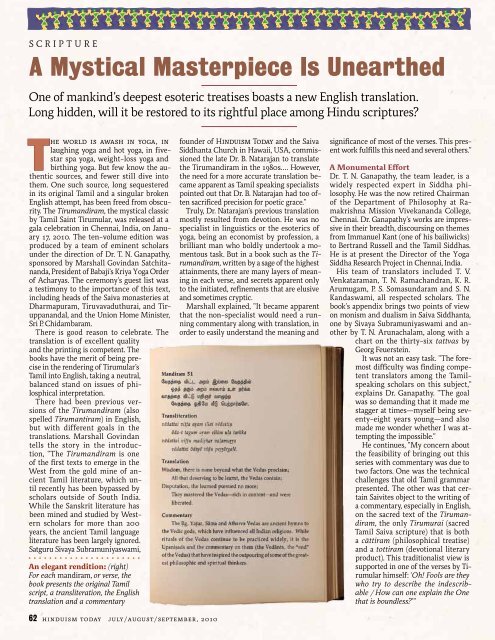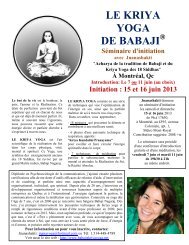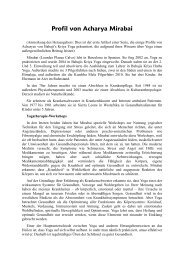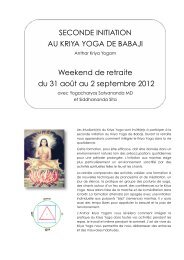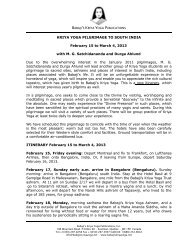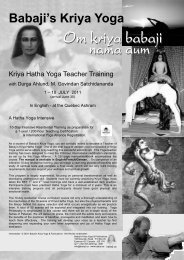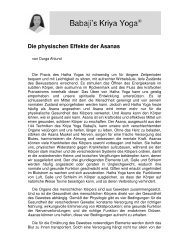read the article - Babaji's Kriya Yoga
read the article - Babaji's Kriya Yoga
read the article - Babaji's Kriya Yoga
- No tags were found...
Create successful ePaper yourself
Turn your PDF publications into a flip-book with our unique Google optimized e-Paper software.
s c r i p t u r eA Mystical Masterpiece Is Unear<strong>the</strong>dOne of mankind’s deepest esoteric treatises boasts a new English translation.Long hidden, will it be restored to its rightful place among Hindu scriptures?The world is awash in yoga, inlaughing yoga and hot yoga, in fivestarspa yoga, weight-loss yoga andbirthing yoga. But few know <strong>the</strong> au<strong>the</strong>nticsources, and fewer still dive into<strong>the</strong>m. One such source, long sequesteredin its original Tamil and a singular brokenEnglish attempt, has been freed from obscurity.The Tirumandiram, <strong>the</strong> mystical classicby Tamil Saint Tirumular, was released at agala celebration in Chennai, India, on January17, 2010. The ten-volume edition wasproduced by a team of eminent scholarsunder <strong>the</strong> direction of Dr. T. N. Ganapathy,sponsored by Marshall Govindan Satchitananda,President of Babaji’s <strong>Kriya</strong> <strong>Yoga</strong> Orderof Acharyas. The ceremony’s guest list wasa testimony to <strong>the</strong> importance of this text,including heads of <strong>the</strong> Saiva monasteries atDharmapuram, Tiruvavaduthurai, and Tiruppanandal,and <strong>the</strong> Union Home Minister,Sri P. Chidambaram.There is good reason to celebrate. Thetranslation is of excellent qualityand <strong>the</strong> printing is competent. Thebooks have <strong>the</strong> merit of being precisein <strong>the</strong> rendering of Tirumular’sTamil into English, taking a neutral,balanced stand on issues of philosphicalinterpretation.There had been previous versionsof <strong>the</strong> Tirumandiram (alsospelled Tirumantiram) in English,but with different goals in <strong>the</strong>translations. Marshall Govindantells <strong>the</strong> story in <strong>the</strong> introduction,“The Tirumandiram is oneof <strong>the</strong> first texts to emerge in <strong>the</strong>West from <strong>the</strong> gold mine of ancientTamil literature, which untilrecently has been bypassed byscholars outside of South India.While <strong>the</strong> Sanskrit literature hasbeen mined and studied by Westernscholars for more than 200years, <strong>the</strong> ancient Tamil languageliterature has been largely ignored.Satguru Sivaya Subramuniyaswami,An elegant rendition: (right)For each mandiram, or verse, <strong>the</strong>book presents <strong>the</strong> original Tamilscript, a transliteration, <strong>the</strong> Englishtranslation and a commentaryfounder of Hinduism Today and <strong>the</strong> SaivaSiddhanta Church in Hawaii, USA, commissioned<strong>the</strong> late Dr. B. Natarajan to translate<strong>the</strong> Tirumandiram in <strong>the</strong> 1980s.... However,<strong>the</strong> need for a more accurate translation becameapparent as Tamil speaking specialistspointed out that Dr. B. Natarajan had too oftensacrificed precision for poetic grace.”Truly, Dr. Natarajan’s previous translationmostly resulted from devotion. He was nospecialist in linguistics or <strong>the</strong> esoterics ofyoga, being an economist by profession, abrilliant man who boldly undertook a momentoustask. But in a book such as <strong>the</strong> Tirumandiram,written by a sage of <strong>the</strong> highestattainments, <strong>the</strong>re are many layers of meaningin each verse, and secrets apparent onlyto <strong>the</strong> initiated, refinements that are elusiveand sometimes cryptic.Marshall explained, “It became apparentthat <strong>the</strong> non-specialist would need a runningcommentary along with translation, inorder to easily understand <strong>the</strong> meaning andsignificance of most of <strong>the</strong> verses. This presentwork fulfills this need and several o<strong>the</strong>rs.”A Monumental EffortDr. T. N. Ganapathy, <strong>the</strong> team leader, is awidely respected expert in Siddha philosophy.He was <strong>the</strong> now retired Chairmanof <strong>the</strong> Department of Philosophy at RamakrishnaMission Vivekananda College,Chennai. Dr. Ganapathy’s works are impressivein <strong>the</strong>ir b<strong>read</strong>th, discoursing on <strong>the</strong>mesfrom Immanuel Kant (one of his bailiwicks)to Bertrand Russell and <strong>the</strong> Tamil Siddhas.He is at present <strong>the</strong> Director of <strong>the</strong> <strong>Yoga</strong>Siddha Research Project in Chennai, India.His team of translators included T. V.Venkataraman, T. N. Ramachandran, K. R.Arumugam, P. S. Somasundaram and S. N.Kandaswami, all respected scholars. Thebook’s appendix brings two points of viewon monism and dualism in Saiva Siddhanta,one by Sivaya Subramuniyaswami and ano<strong>the</strong>rby T. N. Arunachalam, along with achart on <strong>the</strong> thirty-six tattvas byGeorg Feuerstein.It was not an easy task. “The foremostdifficulty was finding competenttranslators among <strong>the</strong> Tamilspeakingscholars on this subject,”explains Dr. Ganapathy. “The goalwas so demanding that it made mestagger at times—myself being seventy-eightyears young—and alsomade me wonder whe<strong>the</strong>r I was attempting<strong>the</strong> impossible.”He continues, “My concern about<strong>the</strong> feasibility of bringing out thisseries with commentary was due totwo factors. One was <strong>the</strong> technicalchallenges that old Tamil grammarpresented. The o<strong>the</strong>r was that certainSaivites object to <strong>the</strong> writing ofa commentary, especially in English,on <strong>the</strong> sacred text of <strong>the</strong> Tirumandiram,<strong>the</strong> only Tirumurai (sacredTamil Saiva scripture) that is botha câttiram (philosophical treatise)and a tottiram (devotional literaryproduct). This traditionalist view issupported in one of <strong>the</strong> verses by Tirumularhimself: ‘Oh! Fools are <strong>the</strong>ywho try to describe <strong>the</strong> indescribable/ How can one explain <strong>the</strong> Onethat is boundless?’”62 hinduism today july/august/september, 2010
“But <strong>the</strong>re is also a statement in <strong>the</strong> Tirumandiramthat can be interpreted asfavorable to our task, which <strong>read</strong>s, ‘TheLord with <strong>the</strong> matted locks stood blemishless/ To those whose mind is like awaveless sea.’ How can <strong>the</strong> BoundlessOne be bound in translations and commentaries?Tirumular provides <strong>the</strong> answer:only those with a clear mind, thatis, a waveless mind like <strong>the</strong> calm deepsea, can comprehend it. Though <strong>the</strong>translators and commentators claim nosuch mind, we seek and obtain protectionin <strong>the</strong> words of Tirumular.”So, is <strong>the</strong> commentary authoritative?Not exactly, says Dr. Ganapathy. “Thecommentaries are meant to be guides,pointing to <strong>the</strong> goal, to <strong>the</strong> essence, but<strong>the</strong>mselves are unrealized, mere descriptionsof truth.” By keeping <strong>the</strong> translationas crystalline as <strong>the</strong>y could, andrelegating all speculation and scholarlyanalysis to <strong>the</strong> commentary, <strong>the</strong> translatorscreated a book that will be interestingto several different audiences, from<strong>the</strong> expert scholar or <strong>the</strong> initiated mysticto <strong>the</strong> beginning student of South Indianmysticism.However impossible it might have seemed,<strong>the</strong> task is now finished. Dr. Ganapathystates in <strong>the</strong> introduction, “In bringing out<strong>the</strong> entire Tamil text in translation, saintCekkilar’s words come before me: ‘Thoughimpossible to reach its limit / Insatiable lovedrives me to <strong>the</strong> task.’ ”h i n d u i s m t o dayA yogi’s treasure:Ten volumes hold 3,000 years of yogic disciplineas penned—more precisely,etched on palm leaves—bySaint TirumularScriptural GreatnessThe Tirumandiram is one of <strong>the</strong> most importantworks related to yoga, tantra, SaivaSiddhanta philosophy and spirituality everwritten (see <strong>the</strong> next page for a story of SaintMular and how this book came to be). It isclosely related to <strong>the</strong> Saiva Agamas, and oftencited as an opus that summarizes <strong>the</strong>m.The book’s first tandiram, or section,prepares <strong>the</strong> aspirant by defining <strong>the</strong> philosophyof Saiva Siddhanta. In <strong>the</strong> secondtandiram, creation and souls are explained,along with <strong>the</strong> five-fold nature of Lord Siva’sactions. In <strong>the</strong> third, techniques for sadhanaand yoga are laid out. In <strong>the</strong> fourth, mantras,yantras and siddhis are described andtaught. In <strong>the</strong> fifth tandiram, <strong>the</strong> four margas(charya, kriya, yoga and jnana) are explained,along with four stages of liberationof <strong>the</strong> soul. In <strong>the</strong> sixth tandiram, advancedsadhanas that lead to jnana are explained. In<strong>the</strong> seventh, divine conduct is prescribed,which includes worship of <strong>the</strong> Sivalingam.In <strong>the</strong> eighth, high states of consciousnessare elucidated; and, finally, in <strong>the</strong> ninth tandiram,<strong>the</strong> experiencing of Lord Siva is expoundedand liberated souls studied.Each tandiram takes up one volume of thiscollection. The tenth volume is comprisedof a glossary, a selected bibliography, anindex and an appendix containing two enlighteningdiscourses on <strong>the</strong> nature of SaivaSiddhanta: whe<strong>the</strong>r it is ultimately monisticor dualistic. It is a discussion crucial toSaivites, <strong>the</strong> culmination of a centuries-longA qualified translator: The eruditeT.N. Ganapathy approached <strong>the</strong> taskwith reverence and some trepidation,leading a team as talented as himselfdebate that questions <strong>the</strong> nature of <strong>the</strong>soul and whe<strong>the</strong>r it ultimately mergeswith Siva in advaitic union.The publisher explains, “It has been achallenge to produce a translation thatwould not take sides in <strong>the</strong> importantphilosophical debate between Saiva Siddhantins[who are] realistic pluralistsand those who see <strong>the</strong> Tirumandiramas an expression of <strong>the</strong> highest mysticalstates of consciousness accessible to<strong>the</strong> Yogi, [a stance called] monistic <strong>the</strong>ism.The views of <strong>the</strong> two sides are in <strong>the</strong>appendix.”Is <strong>the</strong>re a place in our fast-paced modernsociety for such a deep treatise? Isit meant only for yogis and scholars?Dr. Ganapathy addresses <strong>the</strong> questionbeautifully in his introduction: “If religiondeals with ultimate Reality and societyis a common system of ultimate values,<strong>the</strong>n <strong>the</strong>re must be a necessary connectionbetween <strong>the</strong> two. To reveal this necessaryconnection is <strong>the</strong> purpose of <strong>the</strong> Tirumandiram.”Dr. Ganapathy states that <strong>the</strong> Tirumandiram’sontology (a word naming <strong>the</strong>investigation of <strong>the</strong> nature of being) “isbased on <strong>the</strong> notion of <strong>the</strong> Absolute not as aperson, but as a principle and value, an AbsoluteFreedom or a Great Aloneness, calledta∫i urra kê valam in Tirumular’s words.”It’s a book about freedom, liberation, moksa,nirvana or vettaveli.”From its unmatched lofty platform, <strong>the</strong>Tirumandiram proceeds to give guidance ondaily life, prescribing humility, ahimsa, restraintof one’s desires, courage, control of <strong>the</strong>mind, cleanliness and <strong>the</strong> steadfast cultivationof a pure and unswerving love. Whatelse could be more relevant to our times?Tirumandiram, 10 volumes, 3,766 pages. Ordersoutside of India US$100 plus a flat shipping rate ofUS$50; orders in India Rs. 4,400 plus actual shippingfees. To order visit www.babajiskriyayoga.neth i n d u i s m t o dayjuly/august/september, 2010 h i n d u i s m t o d ay 63
to some understanding of <strong>the</strong>se strange happenings. Through hisspiritual insight he discerned that it was Lord Siva Himself whohad taken his body, leaving him to live <strong>the</strong>reafter in <strong>the</strong> body of <strong>the</strong>Tamil cowherd. He took this to be Siva’s message that he shouldkeep <strong>the</strong> South Indian body and serve in that way.He accepted it all as Siva’s will. Of course, <strong>the</strong>re were certain advantages.For one thing, he could now fluently speak <strong>the</strong> languageand knew <strong>the</strong> customs of <strong>the</strong> South.Saint Tirumular began his mission of establishing <strong>the</strong> purity of<strong>the</strong> Saivite path soon <strong>the</strong>reafter when he settled down near Chidambaram.It was <strong>the</strong>re that he began composing <strong>the</strong> Tiru manti ram.Legend has it that <strong>the</strong> sage retired to a cave where he would sit insamadhi for a full year without moving. At <strong>the</strong> end of each year hewould break his meditation long enough to speak out a single Tamilverse giving <strong>the</strong> substance of that year’s meditations. Each versecomposed in this manner was just four lines long, but <strong>the</strong> wisdomeach contained was boundless. He wrote over 3,000 verses in all.This may not be accurate by <strong>the</strong> calendar, but it is true to <strong>the</strong> spiritand quality of <strong>the</strong> Tirumantiram, which has within it <strong>the</strong> wisdom ofthree thousand years of meditation.It takes a bit of meditation to understand <strong>the</strong> Tiru manti ram;it cannot be fully realized by merely <strong>read</strong>ing orstudying from <strong>the</strong> books. But <strong>the</strong> verses of <strong>the</strong>Tirumantiram are understandable if you learnhow to absorb <strong>the</strong>m into yourself. They are importantbecause <strong>the</strong>y tell about what our religionbelieves about inner, spiritual matters—about <strong>the</strong>soul and <strong>the</strong> world and <strong>the</strong>ir relationship to Siva.It is very important to remember that what a personis taught to believe creates his or her attitudestoward o<strong>the</strong>rs and toward <strong>the</strong> world and stimulatesor suppresses desire. Beliefs create attitudes.You must all study <strong>the</strong> great scriptures of our religion. These divineutterances of <strong>the</strong> siddhars will enliven your own inner knowing.The Tirumantiram is similar to <strong>the</strong> Tirukural in many ways.You can teach <strong>the</strong>m both to <strong>the</strong> children and apply <strong>the</strong>ir wisdomto everyday life. You can use <strong>the</strong>m for guidance in times of troubleand confusion, and <strong>the</strong>y will unerringly guide you along <strong>the</strong> rightpath. You can <strong>read</strong> <strong>the</strong>m as hymns after sacred puja in your homeshrine or in <strong>the</strong> temple precincts. Each verse can be used as a prayer,as a meditation, as a holy reminder of <strong>the</strong> great path that lies ahead.Understanding it is a difficult work, but don’t be discouraged bythat. Just accept that it could easily take a lifetime, several lifetimes,to understand all that is contained in this scripture, that it is forthose deep into <strong>the</strong>ir personal sadhana. It was given by <strong>the</strong> saint tothose who fully knew of <strong>the</strong> Vedas and <strong>the</strong> Agamas, and to understandit you too will have to become more familiar with <strong>the</strong>se o<strong>the</strong>rscriptures, slowly obtaining a greater background.The Tirumantiram has been taken from <strong>the</strong> past and magicallytransported into <strong>the</strong> future. Enjoy it. Study it. Meditate upon it. Letit become a part of your inner life, of your understanding of God,man and world.∏πSource of celestial revelations: (below) Nandinathashares Lord Siva’s revelations with hiseight disciples; (right) one of <strong>the</strong>m, Sundaranatha,traveled far south and, in a younger Tamil body,wrote <strong>the</strong> Tirumantirams . r a ja ms . r a ja mjuly/august/september, 2010 h i n d u i s m t o d ay 65


